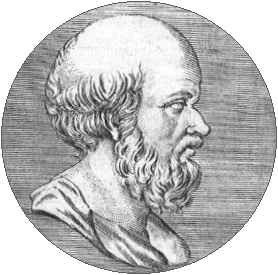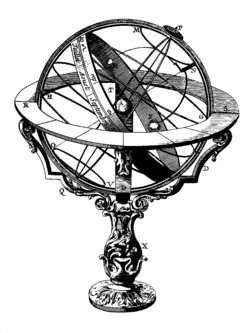



Eratosthenes (276 BC - 194 BC) was a Greek mathematician, geographer and astronomer. His contemporaries nicknamed him "beta" (Greek for "number two") because he supposedly proved himself to be the second in the ancient Mediterranean region in many fields. He is noted for devising a system of latitude and longitude, and for being the first known to have calculated the circumference of the Earth. He also made what he thought was a map of the Earth.
Eratosthenes was born in Cyrene (now in Libya), but worked and died in Ptolemaic Alexandria. He is noted for devising a system of latitude and longitude and computing the size of the Earth.
Eratosthenes studied at Alexandria and for some years in Athens. In 236 BC he was appointed by Ptolemy III Euergetes I as librarian of the Alexandrian library. He made several important contributions to mathematics and science, and was a good friend to Archimedes. Around 255 BC he invented the armillary sphere, which was widely used until the invention of the orrery in the 18th century.
He is credited by Cleomedes in On the Circular Motions of the Celestial Bodies with having calculated the Earth's circumference ca. 240 BC, using trigonometry and knowledge of the angle of elevation of the Sun at noon in Alexandria and Syene (now Aswan, Egypt).
Eratosthenes knew that on the summer solstice at local noon on the Tropic of Cancer, the Sun would appear at the zenith, directly overhead - though Syene was in fact slightly north of the tropic.
He also knew, from measurement, that in his hometown of Alexandria, the angle of elevation of the Sun would be 7¡ south of the zenith at the same time. Assuming that Alexandria was due north of Syene - Alexandria is in fact on a more westerly longitude - he concluded that the distance from Alexandria to Syene must be 7/360 of the total circumference of the Earth.
The distance between the cities was known from caravan travellings to be about 5,000 stadia.There were some errors errors in this calculation. Syene is not exactly on the Tropic of Cancer, and is not directly south of Alexandria; nor is the Sun at infinite distance. (Eratosthenes knew the last, but we are not told he corrected for it.)
More seriously, angles in antiquity could be measured only to degrees or quarter-degrees, and measurement of overland distances was worse. He established a final value of 700 stadia per degree, which implies a circumference of 252,000 stadia.
The exact size of the stadion he used is no longer known (the common Attic stadion was about 185 m), but it is generally believed that Eratosthenes' value corresponds to between 39,690 km and 46,620 km. The circumference of the Earth around the poles is now measured at around 40,008 km.
Eratosthenes' method was used by Posidonius about 150 years later.
About 200 BC Eratosthenes is thought to have coined or to have adopted the word geography, the descriptive study of the Earth.
Eratosthenes' other contributions include:
In 195 BC he became blind and a year later he starved himself to death.
The fragmentary collection of Hellenistic sky-myths called Catasterismi (Katasterismoi) was given an attribution to Eratosthenes, a name to conjure with, to add to its credibility.

An armillary sphere (also known as a spherical astrolabe, armilla, or armil) is a model of the celestial sphere, invented by Eratosthenes in 255 BC.
Its name comes from the Latin armilla (circle, bracelet), since it has a skeleton made of graduated metal circles linking the poles and representing the equator, the ecliptic, meridians and parallels.
Usually a ball representing the Earth or, later, the Sun is placed in its center. It is used to demonstrate the motion of the stars around the Earth.Armillary spheres were developed by the Greeks and were used as teaching tools already in the 3rd century BC.
In larger and more precise forms they were also used as observational instruments, being preferred by Ptolemy.
Armillary spheres became popular again in the Late Middle Ages; the Danish astronomer Tycho Brahe (1546-1601) constructed several of such instruments.Renaissance scientists and public figures often had their portraits painted showing them with one hand on an armillary sphere, which represented the height of wisdom and knowledge.
Armillary spheres were among the first complex mechanical devices. Their development led to many improvements in techniques and design of all mechanical devices.
A representation of an armillary sphere is present in the modern flag of Portugal and has been a national symbol since the reign of Manuel I.